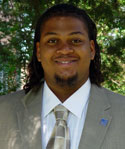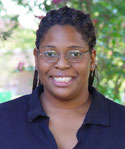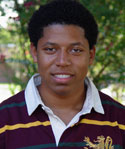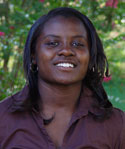|
 |
 |
|
 |
| ECSU URE Summer 2007 Internships |
|
|
|
|
 |

Illiana Thomas
Sophomore - CS
ibthomas@mail.ecsu.edu
|
Creation of a Flexible and Scalable Distributed Computing Infrastructure Using OpenGRID Project Standards
Mentor: Mr. Je'aime Powell, Elizabeth City State University - CERSER
Undergraduate Research Experience in Ocean and Marine Science/Cyberinfrastructure 2007
Abstract
The focus of the ECSU TeraGRID team for the Summer of 2007 was to setup a documentation platform for a Condor-based GRID to be established at Elizabeth City State University. This documentation platform was a Linux based web sever that utilized Web 2.0 standards to create a virtual documentation web portal. Grid computing itself is the creation of a "virtual supercomputer" by using a network of geographically dispersed computers. In order to create such a network infrastructure, documentation is critical to communicate with the users, and the maintainers of the systems.
The web server created utilized an Ubuntu Linux kernel with an Apache web server, a MySQL Database, a PHP scripting package, and a Media Wiki web interface. This particular setup is called a LAMP server. LAMP is the acronym for Linux, Apache, MySQL, and PHP which are all open source applications. The combination of these LAMP applications allows for Media Wiki to function.
Currently installed, the documentation server is now able to utilize, and first display the information on how to re-create a document server. The documentation server is now being used to document how to setup a Condor-based GRID system.
|
|

Jasmin Rivers
Sophomore - CS
jarivers@mail.ecsu.edu
Research Page
Research Paper (PDF)
Research Poster (JPG) |
Use of Microsoft Visual Studio Express Edition and DirectX SDK to Simulate Movements of a Colony of Penguins that must be tagged for a Science Mission Education
Mentors:
Dr. Arvin Agah, University of Kansas - CReSIS
Mr. Tushar Majithia, Elizabeth City State University - CERSER
Undergraduate Research Experience in Ocean and Marine Science/Cyberinfrastructure 2007
Abstract
Our team worked on the development of an educational and entertaining video game, targeted for middle school students, to introduce them to research at the Polar Regions. We enhanced an existing video game, improving the visual quality of the game, and incorporating biologically inspired aspects into the game play. The game consists of a colony of penguins that must be tagged for a science mission in order for the scientist to track the penguins’ movements throughout the year. The penguins move around to avoid being tagged (walk, run, and, slide) and hide behind snow mounds or other obstacles.
In developing this game, we were involved in specifying, designing, implementing, and testing the software for the game. The platforms and packages that were utilized included Visual C++ Express Edition and Microsoft Platform SDK (Software Development Kit). We generated enhanced images for penguins and other objects in the game. We researched the behavior of penguins in order to make the game more realistic, such as studying the walking and running speeds of penguins. The game play was also improved based on the results of testing performed using human subjects, incorporating the feedback from the players. Conducting this research and being involved in developing this game have improved our programming and software engineering skills, while resulting in an entertaining educational resource for middle school students in order to get them interested in STEM disciplines.
|
|


|
GIS Dynamic Web Application Development
Mentor:
Mr. Joseph Ausby
Undergraduate Research Experience in Ocean and Marine Science/Cyberinfrastructure 2007
Abstract
Geographic Information System (GIS) is a collection of computer hardware, software, and geographic data for capturing, managing, analyzing and displaying all forms of geographically referenced information.
Recently, the City of Elizabeth City established its own GIS Division. This division is responsible for managing the City’s geospatial data sources and providing that data content citywide. The GIS Services of the City is currently in Phase I of a multi-year utility asset-mapping program. This endeavor encompasses the entirety of the City’s limits and includes all of the water, sewer, and stormwater utilities. The goal of the City is to use the completed asset mapping data to conduct studies that will improve the existing utility infrastructure to meet future growth of the City.
The project examined the efficiency and methodology of the Elizabeth City Geographical Information Systems Services and its ability to disseminate its geographical data to various City departments. The students will plan, develop and implement a solution that will allow the electronic access of the geospatial data.
The goal of this study was to develop a web-based application that would allow designated users to access the Geographical Information Systems data within the Public Works intranet and later provide this data to the public via the internet.
The software used to complete this project included Microsoft Webdeveloper 2005 Express, Visual Basic and Microsoft Sequel Express 2005 to create the basis of the Web application.
The GIS Web Application Development Team was able to modernize the ability of the GIS Services to deploy its geospatial data in a method that proves efficient, consistent and highly available to its users. This project will coincide with the City’s utility asset mapping program and will serve as the basis for additional web development.
|
|

|
Carnegie Mellon University PHP and MySQL Development for Non-Profit Organizations
Mentors: Dr. Jennifer Foster, Dr. Randy Weinberg, Dr. Larry Heimann
Abstract
The 2007 Carnegie Mellon University Information Systems A-Team developed corporate non profit online websites for Local Pittsburgh Non-Profit Organizations. The A-Team utilized Macromedia Dreamweaver in conjunction with an Apache server to collaborate with Microsoft Access for Database functionality as a daily system backup. The Team utilized PHP and MySql for the systems online Apache database functionality. In addition to Java, Perl and Ruby was utilized for scripting purpose to secure and maintain system integrity. |
|

Research Paper (PDF)
|
Estimating the Average Rate of Volume Change (dv/dt) of Jakobshavn Isbrae to Determine Spatial Patterns of Ice Loss
Mentor:
Dr. Andrew Shepherd
CReSIS International Research Experience Program - University of Edinburgh
Abstract
Recent studies involving the Greenland Ice Sheet (GrIS) have shown increased coastal thinning, based on repeated airborne laser-altimeter surveys (Krabil et al., 2000; Krabil et all., 2004). Altogether, these surveys have shown that the average ice loss from Greenland was 80 ±12 km3 yr-1, between 1997 and 2003 and that thinning rates averaged ~10m yr-1 at many glacier termini. The Jakobshavn Isbrae is considered the fastest moving glacier in Greenland, and in this study we identify “thinning regions” within 250 km radius of its terminus. We use Envisat radar altimeter data recorded during the period 2002-2005 to form time series of elevation change at XX locations across the downstream section of the glacier. From this data, we calculate rates of elevation change (dh/dt) and their associated uncertainty at each of these locations. We estimate the average rate of volume change (dv/dt) of the glacier throughout the survey period, and we analyze the data to determine spatial patterns of ice loss across the Jakobshavn Isbrae
|
|

Unquiea Wade
Junior - CS
unwade@mail.ecsu.edu Research Page
Research PowerPoint
Research Paper (PDF)
Research Poster (JPG) |
Investigation of Power Sources for the Polar Seismic TETwalker
Faculty Mentor: Dr. Arvin Agah
Graduate Student Mentor: Chris Gifford
CReSIS Undergraduate Research Experience - University of Kansas
Abstract
The TETwalker robot was created by NASA Goddard Space Flight Center for space exploration. The goal for this project was to merge the TETwalker platform and technology with seismic surveying to acquire polar seismic data in an innovative fashion. The first objective of this project was to identify reliable power sources for a swarm of TETwalkers. By integrating multiple power sources like solar, wind, and vibration with the TETwalker design, this would make an excellent polar seismic data acquisition robot. The second objective was to adjust the design to accommodate the necessary power sources, along with their size and weight requirements. |
|

Bryce Carmichael
Junior - CS
blcarmichael@mail.ecsu.edu Research Page
Research PowerPoint
Research Poster (JPG) |
Modeling and Simulation for the Polar Seismic TETwalker
Faculty Mentor: Dr. Arvin Agah
Graduate Student Mentor: Chris Gifford
CReSIS Undergraduate Research Experience - University of Kansas
Abstract
The objective of this project was to adapt the design of a robot that was originally created at NASA Goddard Space Flight Center called the TETwalker, in a computer simulation software program to demonstrate the collection of seismic data of ice sheets in Antarctica and Greenland. We will take their design and adapt it for seismic data collection by placing seismic sensors (geophones) in each ground node of the tetrahedral structure, or in the center node for deployment. Seismic methods are analyzed in order to determine which design could possibly be more efficient and reliable in polar environments in terms of geophone deployment and environmental characteristics. |
|

Tiwana Walton
Sophomore - CS
tlwalton@mail.ecsu.edu
Research Paper (PDF) |
Unmanned Aerial Vehicle Mission Planning to Kangerlussuaq, Greenland
Faculty Mentor: Dr. Shah Keshmiri
Graduate Student Mentor: Rylan Jager
Center for Remote Sensing of Ice Sheets (CReSIS), University of Kansas
Abstract
The Center for Remote Sensing of Ice Sheets (CReSIS) is developing an Uncrewed Aerial Vehicle (UAV) for application as a sensor platform in Polar Regions. Existing certification and flight regulations in Greenland do not adequately address the aircraft’s larger size, nor have vehicles of this type been previously operated in the area. This paper will address some of the preliminary efforts undertaken to coordinate and fly the Meridian UAV in Greenland, beginning in 2008. |
|

TreAsia Fields
Math-JR
treasia1567@aol.com
Research Paper (PDF)
PowerPoint
|
Inspire the Next Generation of Explorers
Faculty Mentor: Dollie M. McCown
NASA Langley Aeronautics Research Summer Scholar
Abstract
Enhancing the knowledge of the community about the National Aeronautics Space Administration (NASA) through outreach programs and workshop participation; reaching the youth, home school parents and their students.
This summer, as a Langley Aeronautics Research Summer Scholar (LARSS), I was given the assignment of setting up outreach programs in the community where I would present NASA information and opportunities; providing different options in advancing in the NASA arena.
The most rewarding method of reaching out to the community was through setting up site visitations and presenting NASA information in a fun and exciting way. To be more precise, a point of contact was made to all site supervisors and staff members of different community centers and summer camp programs to arrange a time to come out and present the NASA information to the summer camp students and staff. After doing so, there were meetings held with my supervisor, Dollie M. McCown and Aerospace Education Specialists Rudo Kashiri and Dynae Fullwood to analyze beneficial activities to implement during the presentations.
Furthermore, materials had to be collected including NASA trinkets that would be given at the end of each presentation to leave a lasting impression on the audience. In order for this to become possible, I had to advance in networking with other NASA employees to locate the things that I needed to be successful. Kimberly Land played a major role in assisting me with all NASA valuable, fun and exciting materials.
Not only did I go out into the community and present information about NASA, I had the opportunity to present the problem of the day at the National Institute of Aerospace workshop. This really excited and pleased me to be given such a rewarding task that will be a great asset for my future career in teaching. The problem of the day was to have the different teams design a robotic arm using the craft materials given and have them perform the task of picking up a rubber toy astronaut and dropping it into a cup symbolizing a cargo bank. This was a very instrumental task because this provided an idea of one of Barbara Morgan’s task that she will be performing on the STS 118.
The overall outcome of this project was that information about NASA was presented to the community in a way that they would want to engage in NASA activities and become a part of the NASA team. Everything I expected to happen happened. There were no real difficulties faced; the majority of the activities designed went according to plan. All of the students that were a part of the informal outreach programs really enjoyed themselves and left with a broader mindset about NASA. Mission Accomplished!
This projects contributed to NASA’s missions and goals by revealing past, present and future information and allowing the community, particularly the children to analyze why NASA does what it does and how they can better each mission when they get older. I found that there were a lot of potential scientists, engineers, mathematicians and educators that could contribute a lot to NASA’s mission especially space exploration.
|
|

Amber E. Smith
North Carolina Central University
Sophomore
asmith89@mail.nccu.edu
Powerpoint |
Sub-Glacial Topography and Ice Discharge of the Greenland Ice Sheet
Faculty Mentor: Dr. Kees van der Veen
Center for Remote Sensing of Ice Sheets, University of Kansas
Abstract
The topography of the majority of Greenland was unknown, due to the ice sheet that covers all but the coastlines, until Jonathan Bamber created a map of the bed topography in 2001. By using the map, he was able to determine that bed topography does effect the movement of the ice sheet, but the map did not take into consideration narrow sub-glacial valleys, according to Dr. Kees van der Veen from the University of Kansas. For this project, radar images of Greenland taken by the University of Kansas from 1993 until 2003 were reanalyzed to locate the more narrow valleys. Initial analysis of the bed profiles suggested many of the major drainage routes in the Greenland Ice Sheet were associated with sub-glacial valleys. After identifying what were thought to be the location of the narrow trenches, a comparison with measured surface velocities was made to evaluate whether minor bed topography affects the location and onset of fast glacier flow. |
|
| |
|
|
 |
 |
 |
|
 |
Elizabeth City State University does not endorse, sponsor or provide material located on this site. |
| |
|

